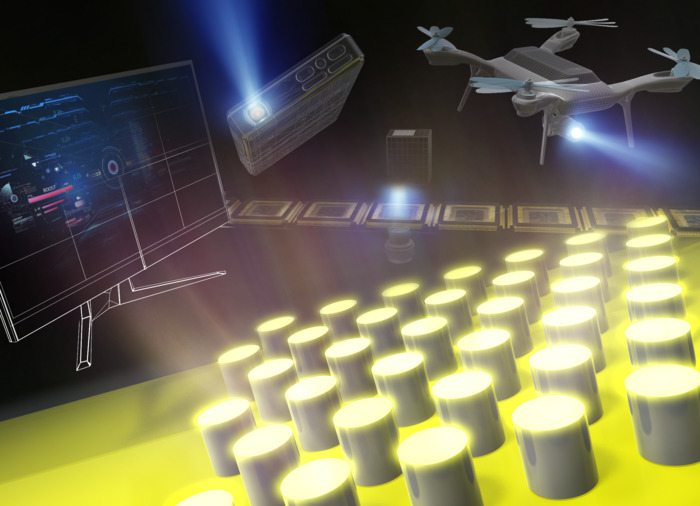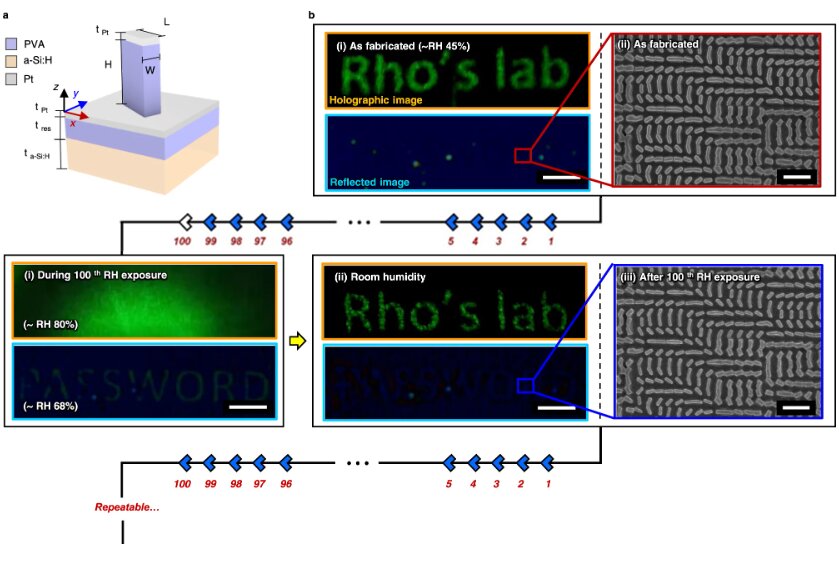
Nanoantenna phosphors comprising of a periodic array of nanoparticles on the phosphor plate can tailor the spatial radiation pattern of the photoluminescence for smaller, lighter and brighter solid-state lighting devices.
CREDIT: KyotoU/Shunsuke Murai
Titanium oxides found to significantly increase efficiency and photoluminescence
White LEDs may soon be dethroned as the world’s go-to light source by an alternative with a much better sense of direction.
As a next-generation optical control technology, a photonic crystal or nanoantenna is a two-dimensional structure in which nano-sized particles are arranged periodically on a substrate. Upon irradiation, the combination of a nanoantenna with a phosphor plate achieves an ideal mix of blue and yellow light.
White LEDs have already been improved upon in the form of white laser diodes, or LDs, which consist of yellow phosphors and blue LDs. While the blue LDs are highly directional, the yellow phosphors radiate in all directions, resulting in an undesired mixing of colors.
To address this issue, researchers have developed phosphor plates combined with nanoantennas using metallic aluminum, enabling increased photoluminescence. Aluminum nanoparticles effectively scatter light and improve light intensity and directionality; however, aluminum also absorbs light, reducing the output. This is a major bottleneck, especially in high-intensity lighting applications.
Now, a team of researchers at Kyoto University has achieved a ten-fold enhancement of forward-directed photoluminescence by replacing aluminum with a better material.
“It turns out that titanium dioxide is a better choice for its high refractive index and low-light absorption,” says lead author Shunsuke Murai.
Although the light-scattering intensity of titanium oxide initially appeared inferior to metallic aluminum, the team used computer simulations to devise the optimal nanoantenna design.
“The new nanoantenna phosphors are advantageous for intensely bright yet energy-saving solid-state lighting because they can suppress temperature rise when irradiated,” explains Murai.
“During the process of finding the optimal dimensions, we were surprised to discover that the thinnest phosphors gave the brightest photoluminescence, demonstrating how to increase the forward radiation intensity and overall performance.”
Original Article: Nanoantennas directing a bright future
More from: Kyoto University
The Latest Updates from Bing News
Go deeper with Bing News on:
Nanoantennas
- Propagating dimensions of light: Deforming versatile non-diffractive beams along the optical trajectory
Furthermore, by leveraging the potential of triple birefringent nanoantennas, we introduced new techniques for structuring light fields, doubling the number of light field types to six (Figure 3).
- Exploring the Revolutionary Impact of Nanoantennas in Nanotechnology
At their core, nanoantennas leverage the principles of plasmonics to interact with light beyond the diffraction limit. This interaction is pivotal for creating highly localized electromagnetic fields ...
- Gregory E. Triplett, Ph.D.
Dean Triplett's research focuses on nanomanufacturing technologies that enable improved electronic and photonic device performance. Check out Dr. Triplett's Precision Imaging Research Lab. Campbell, C ...
- Spasers explained
Specially designed nanoantennas or nanolenses create hot spots of nanolocalized optical fields. One of the advantages of the spaser compared with existing sources of local fields, which also sets ...
- Nanoantennas heat up
Advances in the functionality of multifunctional nanoparticles push their potential for the remote detection and treatment of cancer nearer to real-life patient care. The growth of biomaterial ...
Go deeper with Bing News on:
Photonic crystal
- Information-entropy enabled identifying topological photonic phase in real space
Researchers led by Prof. Xiaoyong Hu at Peking University, China, are interested in topological photonics. They have proposed an interdisciplinary approach to study the topological systems through ...
- A new, low-cost, high-efficiency photonic integrated circuit
The rapid advancement in photonic integrated circuits (PICs), whichcombine multiple optical devices and functionalities on a single chip, has revolutionized optical communications and computing ...
- Electro-Optical Innovation: New Way To Control and Manipulate Optical Signals Developed
The advance could enable the development of compact 3D photonic integrated devices capable of processing large amounts of data and more. Researchers have developed a new way to control and manipulate ...
- Photons Frozen in Time by Innovative Crystal Designs
AMOLF researchers, in collaboration with Delft University of Technology, succeeded in bringing light waves to a halt by deforming the two-dimensional photonic crystal that contains them. The ...
- Unlocking New Potentials: Halting Light in Photonic Crystals Offers Photonic Device Innovation
Advanced technologies in photonic devices such as LED displays, fiber-optics, sensors, and lasers could see a significant leap forward thanks to innovative ways of manipulating light, including ...










